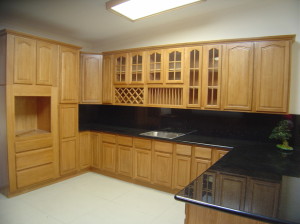Kitchen Cabinets and Countertops
 Revitalize your kitchen by updating your cabinets as well as your countertops. Learn how to achieve this fabulous look.
Revitalize your kitchen by updating your cabinets as well as your countertops. Learn how to achieve this fabulous look.
Things that you will need:
- Safety glasses
- Cabinet order. Specifically to the kitchen. (select one that you personally want)
- Box specifically for the power miter
- Laser level (not mandatory though)
- Chalk line
- Black countertops (it should be 8’ in size)
- Circular saw
- Hammer
- Decking screws. You can choose from either silver or gray. Specifically box 3”
- Speed square
- Saw. Specifically the kind used for the table
- Clamps
- Butcher block. Specifically to be used as your countertop. 4’ in size.
- Pencil
- Countersink bits
- Assembly for the drain
- Builders shims. At least prepare 3 packs.
- P-trap assembly. This will be used to move the sink. Include the accessories as well.
- Measuring tape
- Cordless drill. Select one that already includes the battery. It should also have tip with a screw that is magnetic
- Washers. Specifically for the box finish.
- Level
- Hose for the dishwasher.
The cabinets have already been taken away along with the appliances.
Procedure
First step in this procedure is to get the appliances out of the way. Get the refrigerator out, as well as the dishwasher and store them somewhere outside the kitchen for the meantime. Do the same with the stove and the rest of the appliances. This will make it more convenient for you to move about and do the work with nothing in the way.
Next agenda on the list will be to uninstall the countertop. Unscrew it if in case it is screwed in. If it is nailed up, use the wonder-bar you have prepared. After that, just pry it up. Ensure that the wall does not get ruined while doing so.
Now you can start working on the base cabinets. Remove them off the wall by taking off the screws. Be careful not to hit any connections used for the plumbing and the like. After this, you can proceed in removing the upper cabinets. Use the same procedure you followed on the base cabinets for the upper cabinets.
After you have done away with the existing cabinets you have, sketch a layout for your new cabinet unto the wall with the assistance of a level; doing this will aid you to ensure that there will be no discrepancies in terms of leveling prior to the installation.
Now that you have established which one goes where, you can now start painting. You might have to do some retouches later on but it would still be faster if you do it in this part of the procedure.
It will be more convenient for you to start hanging the cabinets in the upper part rather than the lower ones. There will be nothing in the way yet when you screw it in the wall and you don’t have to reach over anything. If in case the layout for the cabinet folds along a corner, begin at the corner. Do it on either side. If the layout is straight, begin on your feature cabinet (like the one above the sink). Just the same, do it on either side. This is done so that all of them will fit properly and will not be askew. Attach the wall studs to it with the aid of your decking screws (specifically the 2-1/3”). Then, have them attached together with the aid of you 1-5/8” screws.
Make sure that you have some filler strips ready. They come in handy to occupy the space between your cabinet and that of the wall on the final inch or so in your layout.
On your floor, with the aid of a level, locate the highest point and begin from there. It is more convenient to wedge the cabinets up from the low point rather than cutting from high point. Now get the 2-1/2” decking screws you have readied. Attach them to the studs found on the wall by screwing them in.
Some tips: it would be easier for you if you start with screwing together the frames of the cabinet before all else. It would help if the doors are taken off before the cabinets for the upper part are hand. It will not be heavy and will be easier to manipulate. The frames for the front part can be clamped to each other and then screwed together prior to installing them on the wall. With this, in case your wall is not even, the cabinet faces would still appear ok. On another note, decking screws are more appropriate to be used compared to drywall screws. For one, they are thicker at the back on the head and are not prone to break off. They also have the ability to resist moisture, a very crucial point in the kitchen.
Now, use a circular saw and cut the countertops to fit. Then from down below, screw them securely into position.
Note: For countertops that are laminate, always remember to begin cutting from behind. Do not forget to keep the factory edges open and situate the cut edge onto the wall. If it cannot be avoided that the cut edge has to be laid bare, attach a fragment of laminate on it by using contact cement.
Finally, put the sink back into place. Do the same with the appliances and your good to go.
